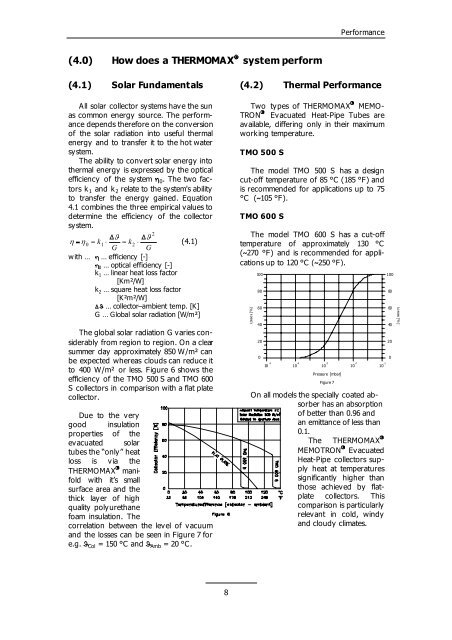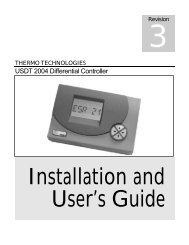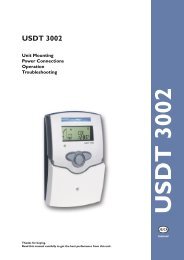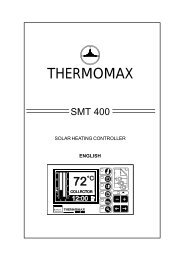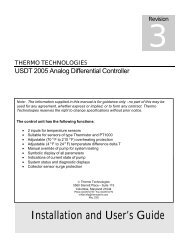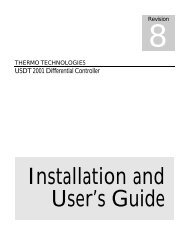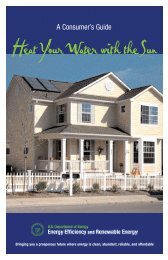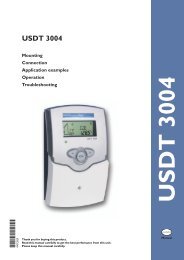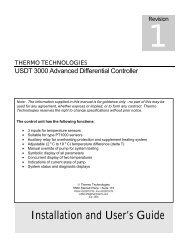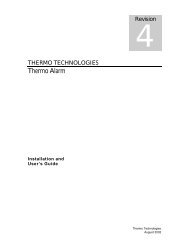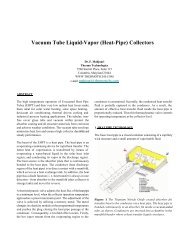ā Evacuated Solar Energy Collector Technical Reference
ā Evacuated Solar Energy Collector Technical Reference
ā Evacuated Solar Energy Collector Technical Reference
You also want an ePaper? Increase the reach of your titles
YUMPU automatically turns print PDFs into web optimized ePapers that Google loves.
(4.0) How does a THERMOMAX � system perform<br />
(4.1) <strong>Solar</strong> Fundamentals<br />
All solar collector sy stems hav e the sun<br />
as common energy source. The performance<br />
depends therefore on the conversion<br />
of the solar radiation into useful thermal<br />
energy and to transfer it to the hot water<br />
sy stem.<br />
The ability to convert solar energy into<br />
thermal energy is expressed by the optical<br />
efficiency of the system � 0.<br />
The two factors<br />
k 1 and k 2 relate to the system's ability<br />
to transfer the energy gained. Equation<br />
4.1 combines the three empirical values to<br />
determine the efficiency of the collector<br />
sy stem.<br />
2<br />
��<br />
��<br />
� ��<br />
0 � k1<br />
� � k2<br />
�<br />
(4.1)<br />
G G<br />
with … � … efficiency [-]<br />
�0 … optical efficiency [-]<br />
k1 … linear heat loss factor<br />
[Km²/W]<br />
k … square heat loss factor<br />
2<br />
[K²m²/W]<br />
�� … collector–ambient temp. [K]<br />
G … Global solar radiation [W/m²]<br />
The global solar radiation G varies considerably<br />
from region to region. On a clear<br />
summer day approximately 850 W/m² can<br />
be expected whereas clouds can reduce it<br />
to 400 W/m² or less. Figure 6 shows the<br />
efficiency of the TMO 500 S and TMO 600<br />
S collectors in comparison with a flat plate<br />
collector.<br />
Due to the very<br />
good insulation<br />
properties of the<br />
evacuated solar<br />
tubes the “only” heat<br />
loss is via the<br />
THERMOMAX � manifold<br />
with it’s small<br />
surface area and the<br />
thick layer of high<br />
quality polyurethane<br />
foam insulation. The<br />
correlation between the level of vacuum<br />
and the losses can be seen in Figure 7 for<br />
e.g. � Col = 150 °C and � = 20 °C.<br />
Amb<br />
8<br />
Performance<br />
(4.2) Thermal Performance<br />
Two types of THERMOMAX � MEMO-<br />
TRON � <strong>Evacuated</strong> Heat-Pipe Tubes are<br />
available, differing only in their maximum<br />
working temperature.<br />
TMO 500 S<br />
The model TMO 500 S has a design<br />
cut-off temperature of 85 °C (185 °F) and<br />
is recommended for applications up to 75<br />
°C (�105 °F).<br />
TMO 600 S<br />
The model TMO 600 S has a cut-off<br />
temperature of approximately 130 °C<br />
(�270 °F) and is recommended for applications<br />
up to 120 °C (�250 °F).<br />
Losse s [%]<br />
100<br />
80<br />
60<br />
40<br />
20<br />
0<br />
10 -5<br />
10 -4<br />
Pressure [mbar]<br />
On all models the specially coated absorber<br />
has an absorption<br />
of better than 0.96 and<br />
an emittance of less than<br />
0.1.<br />
�<br />
The THERMOMAX<br />
�<br />
MEMOTRON <strong>Evacuated</strong><br />
Heat-Pipe collectors supply<br />
heat at temperatures<br />
significantly higher than<br />
those achieved by flatplate<br />
collectors. This<br />
comparison is particularly<br />
relevant in cold, windy<br />
and cloudy climates.<br />
10 -3<br />
Figure 7<br />
10 -2<br />
10 -1<br />
100<br />
80<br />
60<br />
40<br />
20<br />
0<br />
Lo sses [% ]


